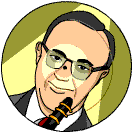Benny Goodman at the Carnegie Hall
Created | Updated Mar 21, 2002

If you ever thought swing was just a little too controlled, a little too buttoned down, have a listen to 'Sing, Sing, Sing', from Benny Goodman's legendary 1938 Carnegie Hall concert. Drummer Gene Krupa brings the band in on a muscular tom-tom racket, the trumpet section attacks with the venom of an angry cobra, and pianist Jess Stacey steals the show with a solo that starts out like the noodlings of an ivory tinkler in an elevator and ends up blowing the roof off. The track was the band's 'killer diller', a fast arrangement aimed at getting the audience out of their seats and up jitterbugging. It closed the Carnegie Hall concert and left the tuxedoed audience bopping in their boxes.
History Making
It is the sound of a band making history, one of the most famous jazz concerts ever, and a moment that changed American music. Of course, no one had any inkling of that beforehand. Goodman later admitted that he didn't know what to expect. At the time, swing was the devil's music of American culture, the hip-hop of the 1930s, corrupting a whole generation of young Americans, giving them all sorts of weird ideas - such as dancing in the aisles, and shaking their bones in a way that was considered lewd and outrageous by their elders. Swing was sex on a stick to the old folks and they were shocked, naturally.
Early Radio Exposure
Goodman hadn't helped. He put his first big band together in 1934, and, with arrangements from Fletcher Henderson, began playing what would become known as swing. The band got a spot on NBC's Let's Dance for a 26-week season, then went out on the road with lousy results (on opening night at Elitch's Garden, in Denver, nightclubbers demanded a refund unless the band played waltzes), until they reached California. The show that really set Goodman, his band, and their new music, on the way, was when they opened at the Palomar Ball-room in Los Angeles on 21 August, 1935, and almost caused a riot. It set a pattern for pandemonium at Goodman's shows.
Cultural Validity
However, Carnegie Hall was something different. This was the most influential concert hall in the US, and Goodman's 1938 concert was the first time that a jazz band had played under its hallowed roof. It gave swing a cultural validity it had lacked up until then, according to Goodman biographer Ross Freston.
Goodman, who died in 1986, went on to a lengthy career full of accolades, but admitted that the Carnegie Hall concert was one of the biggest moments of his life.
That January 16 back in 1938 was a Sunday and a cold one. We didn't quite know what would happen, how it would sound, what the audience would think of it, and we just went out and played.
The place was jammed and, from the first piece, the audience was right behind the band. They didn't know what to expect, either, according to one fan later interviewed by National Public Radio. They were well behaved, aware of their revered surroundings. They clapped and whistled, but there was nothing like the near riots caused by the Goodman Orchestra's west coast appearances.
Best-selling Album
The concert was recorded, with one copy going to the Library of Congress and Goodman keeping the other. He put it away 'for safe keeping', and it wasn't until 1950 that it was released as a double album and went on to become one of the best-selling jazz albums of all time. It was re-mastered by Columbia in 1999 with five bonus tracks from the newly discovered famous 'lost acetates'1.

